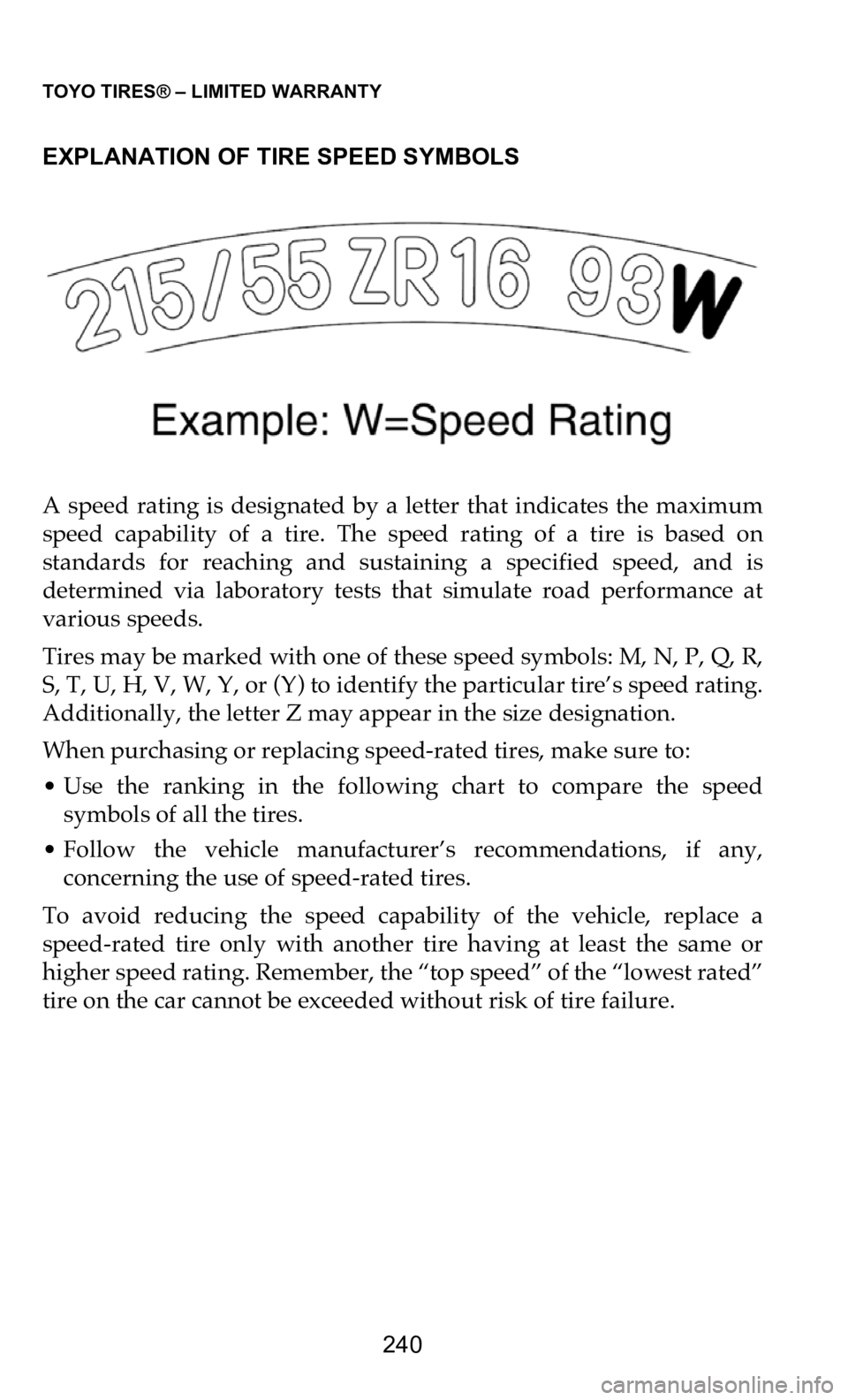DODGE DURANGO 2021 Vehicle Warranty
Manufacturer: DODGE, Model Year: 2021, Model line: DURANGO, Model: DODGE DURANGO 2021Pages: 262, PDF Size: 10.42 MB
Page 241 of 262

TOYO TIRES® – LIMITED WARRANTY
240
EXPLANATION OF TIRE SPEED SYMBOLS
A speed rating is designated by a letter that indicates the maximum
s p
eed capability of a tire. The speed rating of a tire is based on
standards for reaching and sustaining a specified speed, and is
determined via laboratory tests that simulate road performance at
various speeds.
Tires may be marked with one of these speed symbols: M, N, P, Q, R,
S,
T, U, H, V, W, Y, or (Y) to identify the particular tire’s speed rating.
Additionally, the letter Z may appear in the size designation.
When purchasing or replacing speed-rated tires, make sure to:
• Use the ranking in the following chart to compare the speed
s
ymbols of all the tires.
• Follow the vehicle manufacturer’s recommendations, if any,
c
oncerning the use of speed-rated tires.
To avoid reducing the speed capability of the vehicle, replace a
sp
eed-rated tire only with another tire having at least the same or
higher speed rating. Remember, the “top speed” of the “lowest rated”
tire on the car cannot be exceeded without risk of tire failure.
Page 242 of 262

TOYO TIRES® – LIMITED WARRANTY
241
The letter symbols and corresponding design speeds are:
* Any tire with a speed capability above 149 mph (240 km/h) can, at
t h
e tire manufacturer’s option, include a “Z” in the size designation
(e.g., 245/40ZR18). If the load index and the speed symbol are not
included, the tire manufacturer must be consulted for the maximum
speed capability (P245/40ZR18 speed capability is greater than
149 mph [240 km/h]). If a service description is included with the size
de
scription, the speed capability is limited by the speed symbol in the
service description (i.e., 235/45ZR17 97W = maximum speed 168 mph
[2
70 km/h]).
** Although no upper limit speed is specified, the indicated tires
no
netheless have limited rated speed capability. Call 1-800-442-8696
(Pacific Time) or 1-888-444-8696 (Eastern Time) for a referral for more
technical information.
Speed-Rated Symbol Speed Category
M Up to 81 mph (130 km/h)
N Up to 87 mph (140 km/h)
P Up to 93 mph (150 km/h)
Q Up to 99 mph (160 km/h)
R Up to 106 mph (170 km/h)
S Up to 112 mph (180 km/h)
T Up to 118 mph (190 km/h)
U Up to 124 mph (200 km/h)
H Up to 130 mph (210 km/h)
V Up to 149 mph (240 km/h)
W Up to 168 mph (270 km/h)*
Y Up to 186 mph (300 km/h)*
ZR Over 149 mph (240 km/h)**
(Y) Over 186 mph (300 km/h)**
CAUTION!
Tire speed symbols do not imply that vehicles can be safely
dr
iven at the maximum speed for which the tire is rated,
particularly under adverse road and weather conditions, or if the
vehicle has unusual characteristics. Never operate a vehicle in an
unsafe or unlawful manner.
Page 243 of 262

TOYO TIRES® – LIMITED WARRANTY
242
TIRE SPINNING
TOWING OR USE OF SLIDE-IN TRUCK CAMPERS
If you are towing a trailer or using a slide-in truck camper, refer to
y o
ur vehicle Owner’s Manual.
WINTER (SNOW) TIRES Winter driving presents special challenges for vehicle
handling. The use of winter tires, studs, and chains,
wh
ile improving traction performance in snow and ice,
requires additional caution and care with regard to
braking, cornering, and speed. It is important to drive
with care not only on snow and ice, but on dry and wet
roads as well.
• T raction is considerably reduced as snow tires approach 50% tread
w
ear, and replacement should be considered in order to maintain
effectiveness in heavy snow conditions.
• Tire speed rating – When lower-speed-rated winter tires replace
h
igher-speed-rated touring and high performance all-season radial
tires, do not exceed the lower-rated speed.
WARNING!
Spinning a tire to remove a vehicle stuck in mud, snow, or wet
gr
ass can be dangerous. This could cause serious personal injury
or death to a bystander or passenger and extensive vehicle
damage. A tire spinning at a speedometer reading above 35 miles
pe
r hour (55 km/h) can reach a speed capable of disintegrating a
ti
re with explosive force within a matter of seconds. Under some
conditions, a tire may be spinning at twice the speed shown on
the speedometer. Never spin a tire above a speedometer reading
of 35 mph (55 km/h). Never allow anyone to stand near or directly
be
hind the spinning tire. Do not spin if a drive wheel is off the
ground.
WARNING!
Studded tires may require longer braking distances on dry or wet
pa
ved surfaces. Failure to allow for adequate braking distance
could result in serious personal injury or death.
Page 244 of 262

TOYO TIRES® – LIMITED WARRANTY
243
• Follow recommendations in the vehicle Owner’s Manual for winter
tires, studs, and chains.
• Consult your tire dealer, the Rubber Manufacturers Association
w
ebsite
www.rma.org
, or your state’s Department of Transportation
(DOT) for information regarding regulatory and seasonal restric -
tions for stud usage.
• Also see the “Tire Mixing” section in this manual for more details.
•
Toyo Tires recommends that snow tires be installed in matched sets
o
f four.
ADVERSE WEATHER DRIVING
Take special care when driving in adverse weather conditions.
• Rain and snow – Driving in rain or snow considerably reduces the
t
raction between your tires and the road surface. You must always
reduce your speed to allow additional stopping distance between
you and the vehicles ahead of you.
• Hydroplaning and wet weather driving – Hydroplaning occurs on
w
et roads and refers to the loss of tire contact with the road due to
the build-up of water between the tire contact patch and the road
surface. Three main factors affect hydroplaning and, consequently,
your tire traction on wet roads:
1. Vehicle Speed – As speed increases, wet traction is considerably
r
educed.
2. Water Depth – The deeper the water, the sooner your tires will lose
t
raction. Even thin water layers can create sufficient lubrication to
cause traction loss at low speeds, depending on road conditions.
3. Tire Tread Depth – As your tires wear down, their decreased ability
t
o resist hydroplaning can result in a complete loss of traction and
vehicle control. You should always reduce your speed with consid -
eration for the traffic around you.
• Driving on ice and snow – Your all-season tires were designed to
p
rovide higher levels of snow traction compared to non-all- season
tires. You have all-season tires if you find the letters “M&S” are
molded into the sidewall near the bead. These letters mean “Mud and
Snow.” Tires designed for use in severe snow conditions generally
have tread patterns, structure, and materials for giving superior
performance. These tires are marked with the “M&S” designation
Page 245 of 262

TOYO TIRES® – LIMITED WARRANTY
244
plus a mountain/snowflake symbol . Even the best all-season tires
will not provide acceptable levels of traction if you drive too fast in
snow or ice conditions and if you do not allow more stopping
distance on icy roads compared to dry road surfaces. Your ability to
safely maneuver your vehicle in snow or ice conditions is consider -
ably reduced if your tires are too worn to provide adequate road grip.
SAFE USE OF TEMPORARY SPARE TIRES
• T he temporary spare tire is designed for temporary use only. It must
n
ot be used continuously as a standard tire. The temporary spare
tire should be returned to the trunk as soon as it is convenient to
have your standard tire repaired or replaced.
• The temporary spare tire should not be used for speeds exceeding
5
0 mph.
• Never use chains on temporary spare tires, because it could cause
d
amage to your vehicle.
• When you replace the temporary tire, replace it only with the same
t
ype of tire.
• A full-size spare tire in your vehicle is intended for use as a spare
w
hen needed. Please see the “Tire Rotation” section for the proper
procedures for including the same size construction and
speed-rated tire (for LT tires of the same size, type, and load rating)
in the rotation pattern. Do not rotate a temporary spare tire.
WARNING!
The spare tire your car is equipped with may be of a different size
an
d construction from the other tires on your vehicle. When using
any temporary type spare tire, be sure to follow the vehicle
manufacturer’s instructions. Failure to observe recommended
precautions could lead to erratic vehicle behavior and/or tire
damage, possibly resulting in an accident and serious personal
injury or death.
Page 246 of 262

TOYO TIRES® – LIMITED WARRANTY
245
TIRE STORAGE
Tires should be stored indoors in a cool dry place where water cannot
co
llect inside the tires. The tires should be placed away from harmful
ozone-producing electric generators and motors and sources of heat
such as hot pipes. Storage surfaces should be clean and free of grease,
gasoline, or other substances, which can deteriorate the rubber.
WARNING!
• Check inflation pressure before using your spare tire. Failure to
h
ave proper inflation pressure when using your spare tire may
cause loss of vehicle control, which could result in serious
personal injury or death. Maintain spare tire inflation pressures
based on the vehicle Owner’s Manual or the Tire Information
Placard.
• “T” Type high-pressure temporary spare tires should not be
u
sed with any other wheel, nor should standard tires, snow tires,
wheel covers, or trim rings be used on the high-pressure spare
tire wheel. If you fail to follow this warning, your vehicle’s
handling characteristics can be seriously affected. You could
have an accident resulting in serious personal injury or death.
Consult your vehicle Owner’s Manual for the proper use of your
“temporary use” spare tire.
• Do not operate your vehicle with more than one temporary spare
i
n use (this does not apply to a full size spare), and only operate
it at limited speeds and distances as indicated on the sidewall of
the tire.
• The “T” Type temporary spare tire may lower ground clearance
w
hen used. Avoid driving over large obstacles and other road
hazards. Check your vehicle Owner’s Manual for other special
clearance precautions when using the “T” Type temporary spare
tire provided in your vehicle.
Page 247 of 262

TOYO TIRES® – LIMITED WARRANTY
246
COMPETITION TIRE STORAGE
The rubber compounds used in these tires have unique properties
th
at, when compared to other tires, can cause them to lose some of
their flexibility when used or handled in conditions below 15° F
(-9° C). This loss in flexibility can lead to potential cracking and other
da
mage to the tire. To minimize the chances of this happening, you are
advised to follow these instructions:
1. Do not move or operate the car with these tires in conditions below
1
5° F (-9° C).
2. Avoid moving these tires in conditions below 15° F (-9° C).
3
. Before mounting and dismounting, store these tires for at least 24 hours
i
n a temperature- controlled environment of 68° F (20° C) or warmer.
4. Remove these tires from the vehicle and deflate to half the normal
a
ir-pressure during prolonged periods of non-use or storage.
Always inspect tires for signs of cracking and never use tires that
ha
ve cracked.
SPECIAL ADVICE FOR LIGHT TRUCKS
Never exceed the speed limit as indicated by the speed symbol on the
ti
re’s sidewall. See the chart and explanation of speed ratings in this
manual.
If you do not know the speed rating of your Toyo brand tire, contact
yo
ur Toyo Tires® dealer or Toyo Tire U.S.A. Corp. for current
information.
WARNING!
Improper storage can damage your tires in ways that may not be
vi
sible and could lead to serious personal injury or death.
Page 248 of 262

TOYO TIRES® – LIMITED WARRANTY
247
TIRES DESIGNATED AS “LT” WITH NO SPEED RATING
INDICATED ON THE SIDEWALL
It is not recommended that any light truck be operated at speeds in
excess of legal limits. However, if it is anticipated that sustained
driving at speeds in excess of 65 mph may be required, then the
fo
llowing adjustments or recommendations should be followed:
• At speeds from 66
mph through 75 mph, cold inflation pressure
mu
st be increased 10 psi above the recommended pressures for the
load being carried.
• Do not exceed the maximum inflation pressure of the wheel (all
w
heels have maximum allowable inflation pressures).
REPLACEMENT TIRES FOR LIGHT TRUCKS – P-METRIC VS.
LT
-TRUCK
Page 249 of 262

TOYO TIRES® – LIMITED WARRANTY
248
Tire installers should exercise extreme caution when replacing tires on
light trucks.
The maximum load capacity stamped on the sidewall of a P-metric tire
is
reduced by a factor of 1.1 when used on a light truck, a sport utility
vehicle, or a trailer.
When a P-metric or metric tire is installed on a light truck (SUV,
p i
ckup, minivan), the load rating is reduced by dividing by 1.1. (This
load reduction factor is prescribed by Federal Motor Vehicle Safety
Standards (FMVSS) and is based on the expectation that
passenger-type tires may experience more severe loading and usage
conditions when applied to light trucks.) For example, 305/50R20 has
a maximum load capacity of 3086 lbs. If this tire is fitted to a light
truck, the actual allowable load for the tire is 2805 lbs. (3086 lbs.
divided by 1.1).
Consult the load and inflation charts that can be found at
www.toyotires.com
. Contact Toyo Tires® Technical Service with any tire
replacement questions: 1-
800-442-8696 (Pacific Time) or
1-888-444-8696 (Eastern Time).
WARNING!
• P-metric and LT-metric tires are not necessarily interchangeable.
P
-metric and LT-metric tires follow completely different Load/
Inflation tables and are designed to carry different loads at
different pressures.
• LT-metric tires carry their load at higher inflation pressures and
d
o not always have adequate load capacity to replace P-metric
tires of the same size.
• After reducing a P-metric tire’s load rating by dividing by 1.1 for
f
itment on a Light Truck, the P-metric tire may not offer suffi -
cient load capacity to replace an LT-metric tire of the same size.
• Contact your Toyo Tires dealer or Toyo Tires Technical Service
f
or help determining how to choose a proper replacement size.
• Driving with underinflated or overloaded tires may result in
i
mmediate tire failure, which can cause an accident and could
lead to serious personal injury or death.
Page 250 of 262

TOYO TIRES® – LIMITED WARRANTY
249
VEHICLES WITH MODIFIED SUSPENSION
USEFUL TIRE INFORMATION
There is a lot of useful information molded into the sidewall of a tire.
I t
shows the name of the tire, its size, if it is tubeless or tube type, the
maximum load and maximum inflation, and important safety
warnings. The sidewall markings on passenger and light truck tires
are slightly different.
WARNING!
Large-diameter tires and modified suspensions that increase
g r
ound clearance will alter vehicle handling.
• The vehicle may become more likely to roll over.
•
Braking distances may increase.
•
Slower speeds may be required to maintain control.
D
rive with extreme caution until you become familiar with how
yo
ur vehicle handles. Always wear your seat belt.
Some modifications may be illegal in your state. Consult your
Ow
ner’s Manual, the instructions for this product, and state law
before modifying your vehicle.